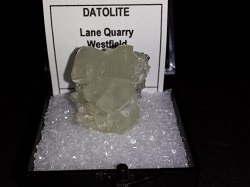A- |
B- |
C- |
D- |
E- |
F- |
G- |
H- |
I- |
J- |
K- |
L- |
M- |
N- |
O- |
P- |
Q- |
R- |
S- |
T- |
U- |
V- |
W- |
X- |
Y- |
Z |
DATOLITE:Uses: As a mineral specimen, rarely as an ornamental stone and as a minor gemstone.Datolite is a popular mineral among mineral collectors although it is somewhat obscure. It forms nicely faceted complex crystals. The crystals at first glance could appear to be other crystal forms such as the isometric dodecahedron or trapezohedron. However these highly symmetric crystal forms are easily distinguished from the crystals of datolite. Datolite's crystals although usually well formed and strickingly faceted lack any symmetry elements except for one mirror plane and one axis of two fold rotation. Datolite is often found in basalt vesicles with calcite and zeolites. In fact, it is often confused with certain zeolites because of its luster, color and associations. Datolite is also found in the Lake Superior region of Michigan. It is associated with native copper at this location and is found in porcelain-like masses and nodules. The nodules are brown to off white in color and some are cut and polished as a ornamental stone.
|

